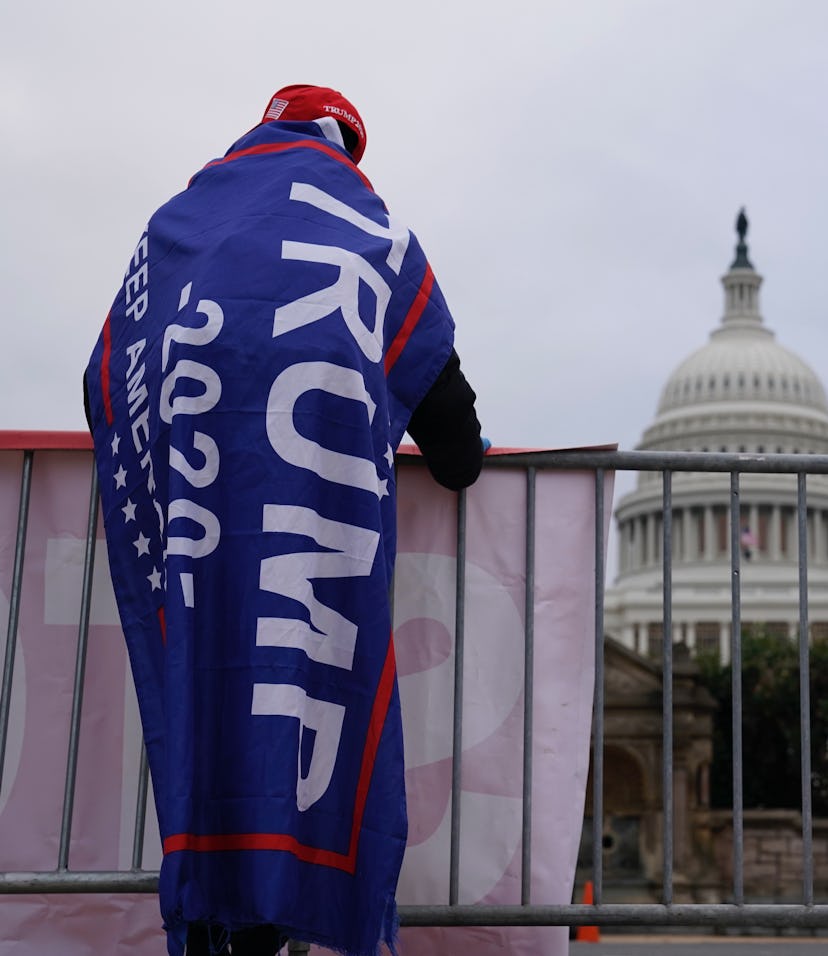Politics
How The Insurrectionists’ Clothes Reveal A Dangerous Cohesion
After extremists stormed the U.S. Capitol, experts find a chilling takeaway in the cacophonous attire.

On Jan. 6, thousands of outraged Donald Trump supporters, clad in white supremacist symbols, descended upon the U.S. Capitol in Washington, D.C., where people proceeded to smash windows, terrorize lawmakers and their staffs, trash offices, and smear blood and excrement on the premises. The insurgents ran the socioeconomic and geographic gamut, and their outfits reflected the breadth of their backgrounds. To put it mildly, there was no dress code.
People wore Trump paraphernalia and MAGA hats. Others donned tactical military gear. T-shirts read “Civil War: January 6, 2021.” At least a few men were photographed in “Camp Auschwitz” sweatshirts and “6MWE” (“Six Million Wasn’t Enough”) clothing — both direct references to Nazi rule, anti-Semitism, and the Holocaust. And another rioter, identified as “QAnon shaman” Jake Angeli, arrived in a fur hat, horns, and face paint.
According to Talia Lavin, an expert on far-right digital radicalization, this cacophony of imagery is a sign of a dangerous cohesion between factions. “What you’re seeing visually represented … is a real intermingling between elements of the more extreme insurgent right and the MAGA mainstream — and the consequential broadening of the groups that are willing to engage in political violence,” says Lavin, the author of Culture Warlords: My Journey Into the Dark Web of White Supremacy. “That is, of course, a worrying trend.” But, she adds, there were through lines. Many of the symbols reflect a distorted take on patriotism, which is a particularly salient message for America’s conservative and far-right audiences. “Certainly there’s a fetishizing of the American Revolution and [people] casting themselves in the role of the second American Revolution,” Lavin tells Bustle. “Of course, the irony [is that] they were there to enforce tyranny rather than fight it.”
Angeli, the fur-clad insurrectionist, also had visible tattoos of Norse iconography all over his body, such as Thor’s Hammer on his stomach and the valknut symbol circling his heart. “There are a lot of white supremacist[s] who have embraced Norse mythology and the worship of the Norse pantheon as a macho aesthetic, like the aesthetics of the Vikings,” Lavin says. “[They’re] reaching back to a very anachronistic and ahistorical idea of the idealized ‘white past.’”
This type of myth-making, in which people co-opt historical narratives or images to dramatize the present, is crucial to many white supremacist groups, both in America and in Europe, according to Virag Molnar, an associate professor of sociology at New York City's The New School. But there are key differences.
Using pagan symbolism is more indirect in Europe, and images like the swastika are banned in many European countries, she says. (In the United States, the swastika is fair game.) Many European nations have outlawed paramilitary groups, which have seen a stateside resurgence in the last few decades. And there’s a “different [value] placed on guns and gun culture in these societies,” she adds. In the United States, gun ownership is interwoven with ideas of a specific American individualism and autonomy.
So where’d the apparel come from? Many of these far-right organizers sell clothing through social media, Molnar says. It could also be from small retailers, who use distributors like Amazon, or ordered ad-hoc from run-of-the-mill custom apparel manufacturers. (In the last week, Amazon has started removing QAnon products.)
Ultimately, the decentralization of the clothing should be seen as a warning, Lavin says. “This is a moment where a broader right-wing coalition that is willing to engage in violence is emerging.”
This article was originally published on